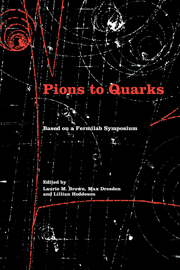Book contents
- Frontmatter
- Contents
- List of contributors
- Foreword by Leon M. Lederman
- Editors' acknowledgments
- Photographs of the symposium
- List of abbreviations
- List of notation
- I Introduction
- II Particle discoveries in cosmic rays
- III High-energy nuclear physics
- IV The new laboratory
- 9 The making of an accelerator physicist
- 10 Accelerator design and construction in the 1950s
- 11 Early history of the Cosmotron and AGS at Brookhaven
- 12 Panel on accelerators and detectors in the 1950s
- 13 Accelerators and the Midwestern Universities Research Association in the 1950s
- 14 Bubbles, sparks, and the postwar laboratory
- 15 Development of the discharge (spark) chamber in Japan in the 1950s
- 16 Early work at the Bevatron: a personal account
- 17 The discovery of the antiproton
- 18 On the antiproton discovery
- V The strange particles
- VI Weak interactions
- VII Weak interactions and parity nonconservation
- VIII The particle physics community
- IX Theories of hadrons
- X Personal overviews
- Name index
- Subject index
12 - Panel on accelerators and detectors in the 1950s
Published online by Cambridge University Press: 07 May 2010
- Frontmatter
- Contents
- List of contributors
- Foreword by Leon M. Lederman
- Editors' acknowledgments
- Photographs of the symposium
- List of abbreviations
- List of notation
- I Introduction
- II Particle discoveries in cosmic rays
- III High-energy nuclear physics
- IV The new laboratory
- 9 The making of an accelerator physicist
- 10 Accelerator design and construction in the 1950s
- 11 Early history of the Cosmotron and AGS at Brookhaven
- 12 Panel on accelerators and detectors in the 1950s
- 13 Accelerators and the Midwestern Universities Research Association in the 1950s
- 14 Bubbles, sparks, and the postwar laboratory
- 15 Development of the discharge (spark) chamber in Japan in the 1950s
- 16 Early work at the Bevatron: a personal account
- 17 The discovery of the antiproton
- 18 On the antiproton discovery
- V The strange particles
- VI Weak interactions
- VII Weak interactions and parity nonconservation
- VIII The particle physics community
- IX Theories of hadrons
- X Personal overviews
- Name index
- Subject index
Summary
Jones: The discussions are organized as follows: first some remarks on the subject of particle accelerators in the 1950s, then some remarks on particle detectors. Although people like Luis Alvarez bridge both fields, generally the two fields are more or less discrete. Robert R. Wilson deals with aspects of particle accelerators from the Cornell perspective; in a separate chapter in this volume, Donald Kerst summarizes the MURA developments in the 1950s;* Robert Hofstadter discusses detectors, in particular the development of solid inorganic scintillators. Ugo Amaldi and Alvarez then take up other aspects of particle detectors. The panel concludes with a general discussion, including responses to questions from the floor.
It may be useful at this point to summarize the accelerator and detector technologies that were available at the beginning of the 1950s, and then briefly catalog the conceptual advances and inventions during that decade. Electron acceleration techniques evolved rapidly during the 1940s, beginning with the invention of the betatron by Kerst and, following the war, the development of the electron-synchrotron by Edwin McMillan. Meanwhile, William Hansen and others invented and developed the electron linear accelerator, substantially in the form it has retained to the present. The proton accelerators before 1950 were at first high-voltage machines, developed by John Cockcroft and Ernest T. S. Walton, then electrostatic generators developed by Robert J. Van de Graaff and Raymond G. Herb, followed by Ernest O. Lawrence's cyclotron. Postwar developments included the synchrocyclotron of McMillan and Vladimir Veksler and the Alvarez proton linear accelerator.
- Type
- Chapter
- Information
- Pions to QuarksParticle Physics in the 1950s, pp. 185 - 201Publisher: Cambridge University PressPrint publication year: 1989
- 1
- Cited by



